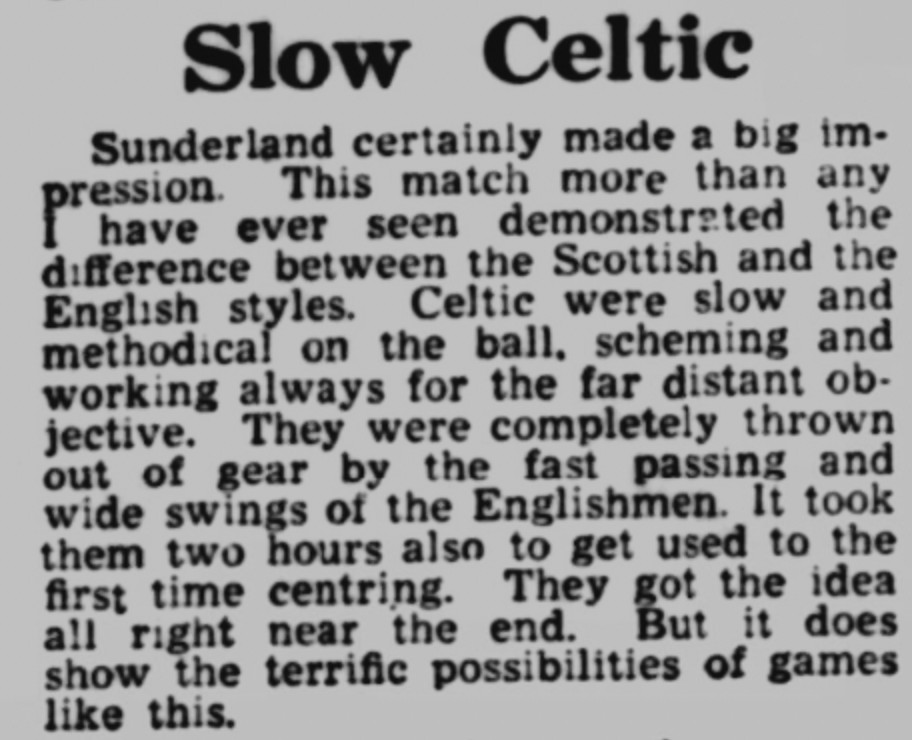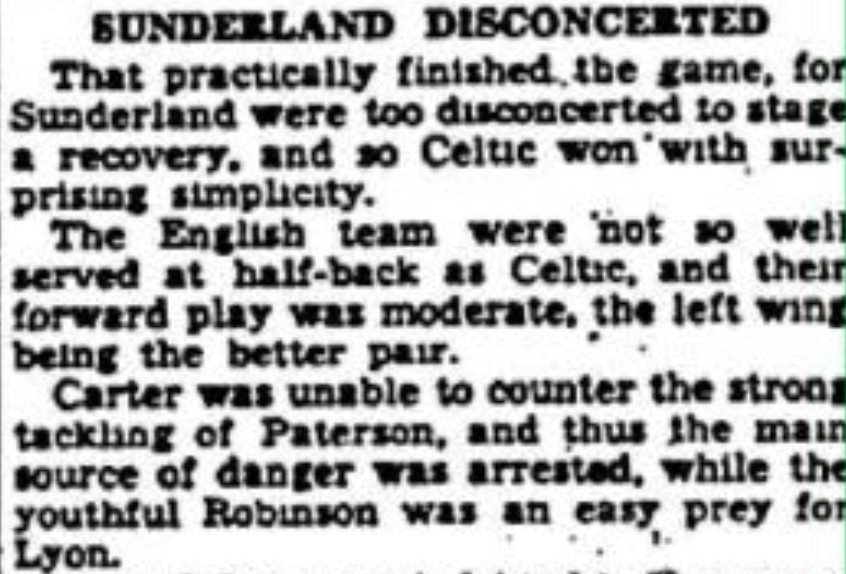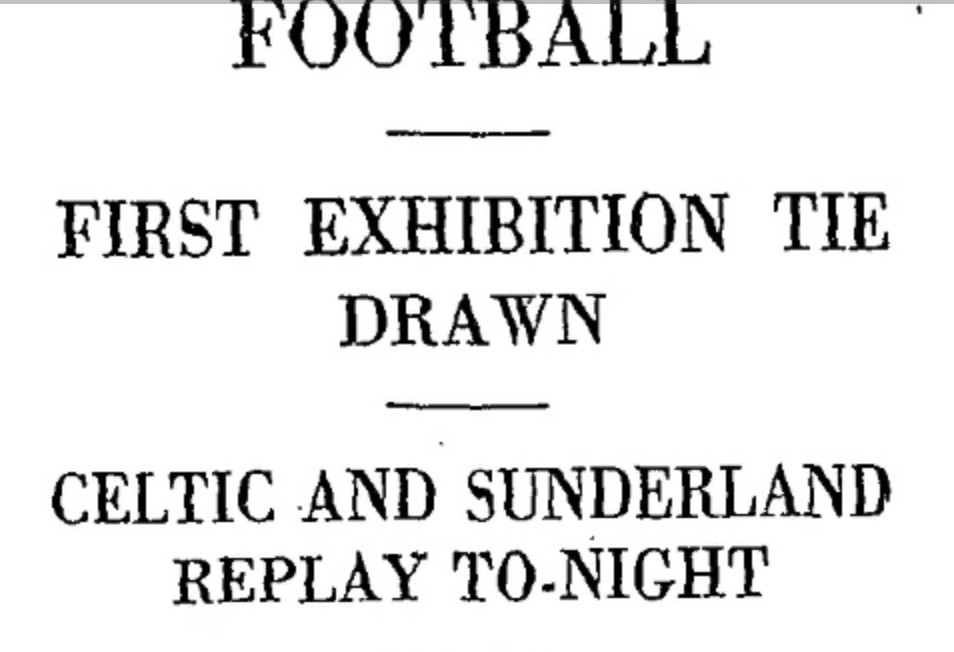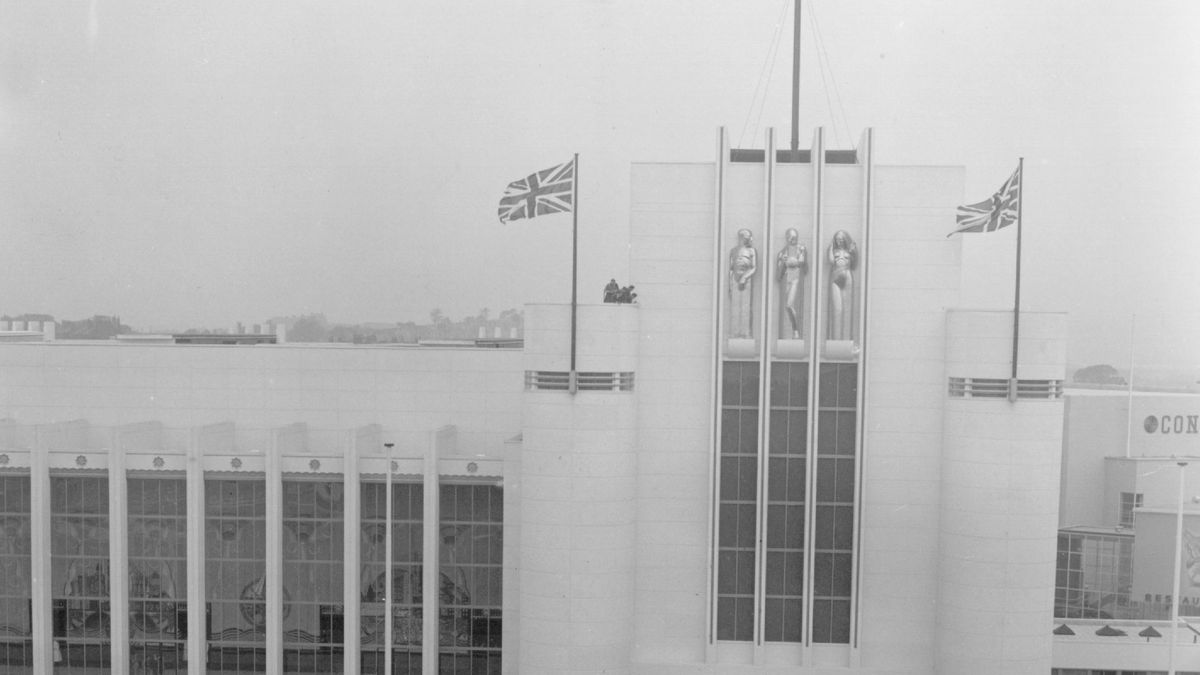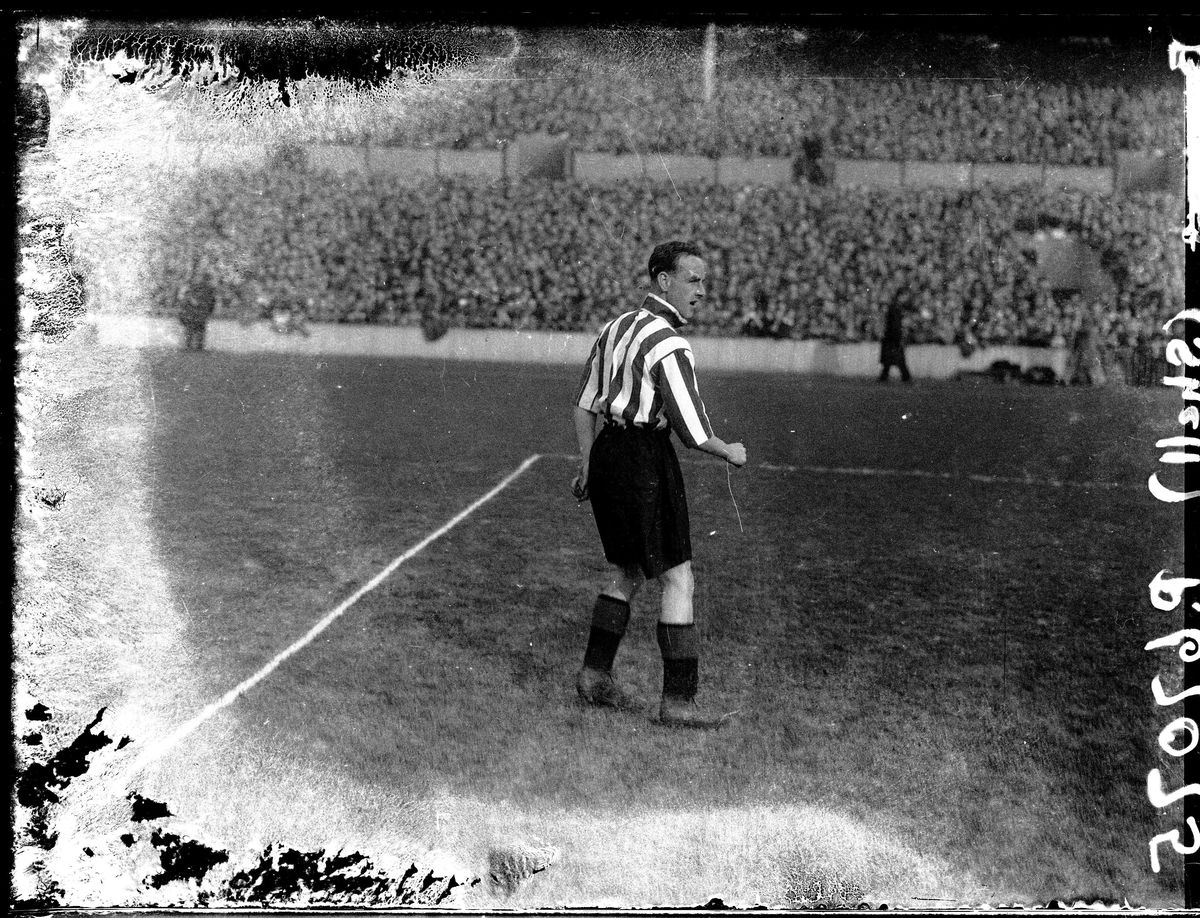| Match Pictures | Matches: 1937 – 1938 | 1938 Pictures |
Trivia
- Sunderland opened the scoring in 28 minutes through Percy Saunders, but ten minutes later Johnny Crum equalised, then John Divers scored two in the first period of the second-half, and the Celtic go on to the semi-finals to face Hearts.
- Tournament Background and Matches: Empire Exhibition Cup
- This replay on Thursday 26th May follows Wednesday’s goalless draw (after extra-time) between the sides.
- Sunderland came to this tournament as recent FA Cup holders having beaten Preston 3-1 to win the 1937 FA Cup.
- Sunderland won the 1937 FA Cup with 5 Scots in the team.
- Horatio “Raich” Stratton Carter who scored in the 1937 cup-final is believed to be the best ever player to wear the red and white stripes of the Wearsiders.
- Kennaway’s saves and Paterson’s tackling nullified the skills of Carter,Sunderland’s main attacking threat.
Review
Teams
CELTIC:
Kennaway, Hogg, Morrison, Geatons, Lyon, Paterson, Lynch, MacDonald, Crum, Divers, Murphy.
Scorers:
Crum, Divers, (2).
SUNDERLAND:
Mapson, Gorman, Hall, Horsam, Lockie, Hastings, Spuhler, Carter, Robinson, Saunders, Burbanks.
Scorers:
Saunders.
Referee: M. C. Hutton (Glasgow).
Attendance: 20,226
Articles
- Match Report (see end of page below)
Pictures
Articles
The Scotsman – Friday, 27th May 1938, page 6
EXHIBITION TOURNAMENT
CELTIC WIN REPLAY AGAINST SUNDERLAND
CELTIC, 3; SUNDERLAND, 1.
Before a crowd that rainy weather limited to 20,000, Celtic defeated Sunderland in the replayed Empire Exhibition tournament first round tie at Ibrox last night.
Only the first half repeated the thrills of the previous night. Sunderland falling away badly in the second-half.
The English team scored first, Saunders dribbling his way from the touch-line right to the goalmouth, to beat Kennaway easily. That was twenty-eight minutes after the start.
Ten minutes later the scores were level. Crum, from eight yards sending in a high ball. Mapson got his hands to it but allowed the leather to slip through them to the net.
Four minutes after the restart Crum and Divers got through in a mazy run, for the latter to place the ball with his left foot well out of Mapson’s reach.
Ten minutes afterwards the same player went through on his own to walk the ball right past the goalkeeper. Sunderland after that played like a well beaten team.
On This Day (26 May 1938): Sunderland fall to Celtic as the Scots progress in Empire Cup replay
Sunderland took part in a “celebration of Empire” by playing Celtic twice in two days. In the end, it took 210 minutes to separate the two giants!
By DaveyBrowne37 May 26, 2022, 6:00am BST
A large crowd gathered outside the United Kingdom pavilion to see King George VI (1895 – 1952) and Queen Elizabeth at the official opening of the Empire Exhibition. The exhibition, held at Bellahouston Park near Glasgow, offered a range of exhibits including demonstrations of traditional crafts and a fun fair with a Giant Racer rollercoaster | Photo by Topical Press Agency/Getty Images
Source: https://rokerreport.sbnation.com/2022/5/26/23141013/on-this-day-26-may-1938-sunderland-fall-to-celtic-as-the-scots-progress-in-empire-cup-replay
It took 210 minutes of football over the course of two days, but Sunderland’s valiant attempt to overcome the Scottish league champions Celtic came to an end at Ibrox on this day 84 years ago.
The Empire Cup was an end of season invitational tournament held to coincide with the 1938 Empire Exhibition in Glasgow, a celebration of the Scottish metropolis’ contribution to the British imperial economy and boost the increasingly discredited idea of empire in general at a time when national liberation movements were stirring across the United Kingdom’s global “Commonwealth”.
The opening match of the Empire Exhibition Trophy competition was between the two premier clubs involved, Sunderland and Celtic, and took place on 25th May. Whilst Rangers, Hearts, and Aberdeen – the first and second-placed clubs in Scottish Division 1 in 1936-37 – completed the Scottish contingent, the English participants comprised our fellow English Division mid-table also-rans Brentford, Everton, and Chelsea alongside the 1937 FA Cup winning Wearsiders.
Soccer – Football League Division One – Sunderland
Eddie Burbanks, Sunderland Photo by Barratts/PA Images via Getty Images
Sunderland’s team comprised some of the great names of the 1930s – Raich Carter, Bobby Gurney, Jonny Mapson, Patsy Gallacher, and Eddie Burbanks. Trips had been laid on by local travel agents, ensuring that the visitors from the north east had some away support for the match.
The quarter-final was played in front of around 53,000 at the home of Celtic’s “Old Firm” rivals Rangers ended 0-0 after 30 minutes of extra time, but during this time Sunderland had managed to win over the Scottish crowd through their progressive and attractive football. Alan Breck, writing in The Evening Times the following day, summarised the action as follows:
The teams played for two hours last night without scoring a goal. The longer the game lasted the stronger Sunderland became. At the end John Cochrane’s boys were fresh and frisky compared with Celtic. I fancy Sunderland have the defensive and half-back power which Celtic lack, and moreover it is doubtful if Carruth and Delaney will be able to take part in the replay…
…Those who expected exhibition football for the Exhibition Cup must have been amazed. It was a raging cup-tie, teeming with life and incident. The pace was terrific, and, as I say, Sunderland lasted that better.
Indeed Celtic looked exhausted at the end. Geatons, who had played so brilliantly, was tired out, and you could also see signs of distress elsewhere.
Definitely Sunderland must have trained very carefully for the tournament. No one is keener to win the trophy than John Cochrane. It would be a grand thing for his board-room, in which hangs the photograph I took of him and the late Herbert Chapman.
Sunderland also managed to rough up the referee Mr. Mungo Hutton, jostling the local official when decisions didn’t go their way. John Macadam in the ‘Mack’s Crack’ column in the London Weekly Dispatch sheet recounted a remark from a Scottish supporter who was leaving the match early to the man on the Ibrox gate, “Hey, send for the polis! Celtic are getting murdered in there!”
It was, according to Macadam, the perfect example of why a British Football League would be a great success – two of the world’s great teams had provided one of the most entertaining and enthralling encounters of the season in what was nominally a friendly match.
Related
The Celtic Wiki: 1938-05-25: Celtic 0-0 Sunderland, Empire Exhibition Cup QF
London Weekly Dispatch, 29/5/1938
A replay was ordered for the following day – a turnaround we simply couldn’t imagine in modern football. Sunderland followed Celtic in making Bobby Gurney and Patsy Gallagher sat out the second game, which only attracted a crowd of 20,000 due largely to the Glasgow rain. The game was to be played to a finish – 30 minutes extra time would be followed by an addition 15, and – as the penalty shootout had not yet been invented – if they still couldn’t be separated the game would be decided by a committee!
Goalkeeper Joe Kennaway was the hero or Celtic, tipping over a drive from Carter, saving from point blank range from Burbanks, and making other vital interventions to keep the Lads at bay. Almost half an hour passed before the deadlock was broken, Sunderland’s backup forward Percy Saunders cut inside from the right wing, dribbled past the Celtic defence, and finding the net.
The lead only lasted ten minutes, however. A mistake from Mapson saw the ball slip between his hands and into the Sunderland net, and after the break, a combination of John Crum and John Divers scored two more from dibbled breakaways, with our keeper well beaten on both occasions.
Exhausted, and struggling to cope with the conditions, Sunderland couldn’t recover and were eliminated from the tournament at the first stage. It was their final game of a disappointing season, although they had reached the FA Cup semi final, the team that had dominated the middle of the decade seemed to be running out of steam with Arsenal, Everton, and Wolves taking over the mantel of the top sides in the division.
This was only a few months before the outbreak of global war once more. Our goalscorer Saunders served as a sergeant in the British Army during the war and would be tragically killed by a Japanese torpedo three years later when attempting to escape the invasion of Singapore and Malaya aboard the Dutch steamer SS Rooseboom. Things would never quite be the same again for Sunderland AFC, and the club’s golden age was behind us.
Celtic would go on to beat Hearts in the semis and Everton in the final to lift the trophy. Over 12.8 million would attend the Exhibition overall, which made a loss of £130,000 but left some fine art-deco architecture in and around the city.
The imperial realm itself would, thankfully for the hundreds of millions who suffered the degradation of foreign domination over centuries, begin to disintegrate shortly after the end of the second world war, defeated by the forces of nationalism, socialism, and post-war economics.
Its legacy remains with us to this day, unresolved to a large extent, whitewashed by an education system obsessed with Tudors and Nazis, and celebrated by those who know little of the actual history or intergenerational consequences of European colonialism.
But the “joint enterprise” of England and Scotland in developing and popularising football and other organised sports across the world is perhaps the single most incontrovertibly positive mark that the British empire left on the modern world.
It is a relationship that created our club, made it great, and continues to shape its present and future. It bridges sectarian, national, and linguistic divisions to provide a common reference point for all people, and for that, it’s worth celebrating each and every day.


